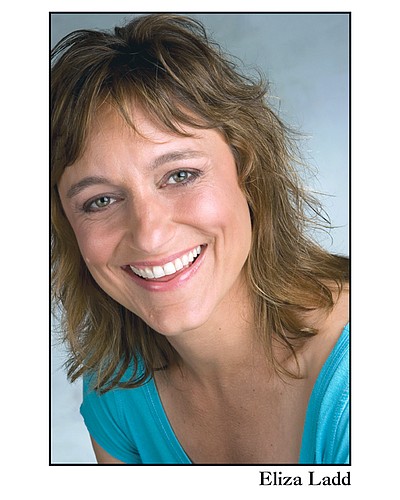- April 25, 2024
-
-
Loading

Loading

Eliza Ladd never stops moving. She’s on her feet now, visibly pregnant, but it doesn’t slow her down. Her hands gesture, her eyes follow various moving targets — namely four New College students. Today, she’s running them through the paces of “Selfie of the Ancients,” her composition for the upcoming New Music, New College festival. Each student holds a bamboo staff. So does Ladd.
Staffs in hand, the students stand in a cluster in one corner, weaving back and forth and making the sound of wind. They wait expectantly …
Ladd whacks her stick on the mat and calls out a bit of shorthand.
“Crack hunt!”
They scatter to the corners of the room, sweep their sticks in front of them like hockey players, then converge again in the center.
I just stand there watching the action for a while. Circular motion, echoes of martial arts, the bits and pieces of mime. What’s going on, exactly? Ladd fills me in at the next break.
They’re rehearsing in New College’s Black Box Theater, which looks very much like the interior of a giant black box. But “rehearsing” is the wrong word. A visual artist starts with a rough pencil sketch, and then refines it. Ladd does the same thing with movement. What I’m seeing now is a sketch in motion and sound — for a collaborative work.
“I originated the core elements, but it’s coming through their bodies,” says Ladd. “They’re not automatons; I have to use who they are, all their different motions and expressions, and that becomes part of the final composition.”
Today, they’ve been working on “Ground Liturgy.” Ladd stresses it’s only a small part of “Selfie of the Ancients.”
While we’re on the subject, the ancients didn’t have cell phones. So how could they … Ladd laughs and asks me to think about what a selfie means.
“A selfie says, ‘Look at me! Here I am!’” she says. “It’s the purest expression of contemporary egotism. The ancients obviously couldn’t speak to us through technology. But they could say, ‘Look at me!’ through gesture and the building blocks of music and language. My composition draws on that tribal notion of self — it’s a portrait of humanity as an ensemble, not me myself and I.”
As Ladd sees it, it’s not an abstract concept. The genes of our ancestors haven’t gone away, and neither have the memes — snippets of repeated actions over time: The simple act of stirring — just moving a stick in a circle; pouring a bucket of water; taking a step.
But also sounds: the rolling of a heavy piece of iron; the rush of wind.
“The past hasn’t gone away,” she says. “It’s still part of us. It’s right here, and the students and I can immediately tap into it as an ensemble.”
And now we’ve entered Joseph W. Campbell territory. The giant shadow of “Finnegans Wake” covers all. Sure. But clever English-major theories about archetypes are one thing. Bringing them to life is another. And that’s where Ladd’s ambition lies. And she’s not alone.
The students stretch, then introduce themselves: Julia Frichter, Eugenia Titterington, Elijah Weiss and Alyson Hart — an alert bunch. They all seem focused, and positively psyched. They clearly share Ladd’s ambition. But on a mundane level, they’re also working on an independent study project, and not an easy one.
To bring them up to speed, Ladd immersed them in images of the first cave artists, the sounds of dolphin echolocations and the permutations of non-traditional music, from the primitive to the avant garde. A tough assignment. But the truth is, they all seem very relaxed.
“They’re an open, intelligent group,” says Ladd. “They’re fearless and willing to go anywhere. They don’t bring a lot of preconceived ideas to the table.”
This section was punctuated with the sounds of wind and a few cracks of the stick. The composition as a whole will blur the lines of music and movement.
For one section, Ladd boiled a Shakespeare passage down to its vowels. For another, she translated a poem into American Sign Language and expanded the gestures into dancelike forms. And naturally, the floor will have a microphone.
“This is a hybrid art form,” Ladd says. “I’m not sure what to call it. I’m not big on pigeonholes.”
Break time is over, and the workaday theater transforms into a sacred space again. Ladd and the students are back in motion. I don’t have an easy pigeonhole for what they’re doing.
But it definitely looks like a lot of fun.